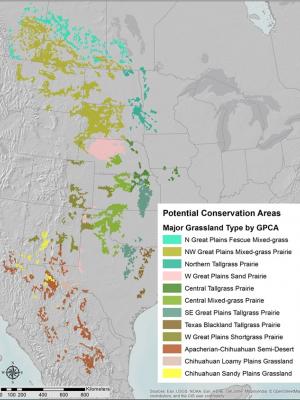 In 2013 the North American Intergovernmental Committee on Cooperation for Wilderness and Protected Areas Conservation (NAWPA Committee) agreed to examine the adequacy of the North American conservation estate, considering key attributes of ecological representation, connectivity and resilience. Working with temperate grasslands as a pilot area, analyses concentrated on twelve major grassland ecosystem types that occur across the Great Plains and Chihuahuan Desert regions.
In 2013 the North American Intergovernmental Committee on Cooperation for Wilderness and Protected Areas Conservation (NAWPA Committee) agreed to examine the adequacy of the North American conservation estate, considering key attributes of ecological representation, connectivity and resilience. Working with temperate grasslands as a pilot area, analyses concentrated on twelve major grassland ecosystem types that occur across the Great Plains and Chihuahuan Desert regions.
NatureServe has completed a series of analyses and products in support of NAWPA agency discussions throughout 2015-2017. These included:
1. Expert review and refinement of grassland type descriptions and maps.
2. Documented historical trends of loss of the 12 major grassland types of the Great Plains.
3. Associated species of concern with each of the 12 temperate grassland types.
4. Documented resiliency of grassland distributions that considered grassland patch size, current landscape intactness, and core areas.
Most severe declines in grassland extent have occurred in tallgrass prairie types, followed by mixed-grass, shortgrass, and semi-desert grasslands. Similar trends by type were documented for landscape intactness and connectivity. Some 174 species of vertebrates, invertebrates, and plants considered by NatureServe as critically imperiled, imperiled, or vulnerable, are strongly associated with these grassland types, and 103 are listed under protective legislation in one or more country. Just 1.2% of historic extent for all types combined is currently found within designated protected areas.
The project then aimed to advance the Convention on Biodiversity 2020 target number 11 of representing the diversity of these grassland types in Grassland Potential Conservation Areas (GPCAs). These areas could provide one important focus for conservation actions to secure or restore grassland habitat. NatureServe ecologists deployed systematic, science-based methods, tools, and data to identify efficient configurations for augmenting the current grassland conservation estate. Grasslands distributions, current managed areas, already proposed conservation areas, landscape resiliency measures, and available distributions for species of concern (e.g., Lesser Prairie Chicken, Greater Sage Grouse, Natural Heritage occurrences, etc.) were used to draft GPCAs using a hexagonal grid (100km2 each)
A total of 177 Grassland Potential Conservation Areas (GPCAs) were identified to represent grassland type diversity in areas least likely to conflict with other land uses. NatureServe coordinated expert review and refinement by specialists from NatureServe network programs (MT, NE, KS, TX, NM, Chihuahua) and from specialists identified by NAWPA agencies. Within identified GPCAs, type-specific representation varied from a low of just 1% of historic extent for Texas Blackland Tallgrass Prairie to a high of 27% for Western Great Plains Sand Prairie. Combined across all twelve grassland types, 15% of historic extent is represented.
In order to support development of conservation strategies, other conservation priorities associated with each GPCA were documented, including current conservation investments and other prioritization efforts, such as sites identified by The Nature Conservancy and Nature Conservancy of Canada ecoregional plans. Current landscape stressors associated with each GPCA were also documented.
This website on DataBasin.org provides ready public access to materials generated through this effort. https://databasin.org/articles/bfb06dd10a6a4c1da3e89653562b182e
A presentation on this effort is found here: https://youtu.be/McVhFeVy-hs
A peer-review publication on this project appears in the April 2018 in the Natural Areas Journal.
Comer, P.J., J.C. Hak, K. Kindscher, E. Muldavin, and J. Singhurst. 2018. Continent-Scale Landscape Conservation Design for Temperate Grasslands of the Great Plains and Chihuahuan Desert. Natural Areas Journal Vol. 38, Number 2: 196-211
The primary goal of this effort was to systematically assess current biodiversity values associated with major temperate grassland types of the trinational area, and then identify Potential Conservation Areas to emphasize grassland conservation.
This analysis documented long-term trends in extent of major temperate grassland types from the Canadian prairies, Midwest and Great Plains USA, and Chihuahuan Desert of Mexico. It documented at-risk species associated with these types, current protected areas status, and relative intactness of supporting landscapes. It then identified Potential Conservation Areas where grassland conservation could be targeted to advance continental-scaled goals for ecological representation.